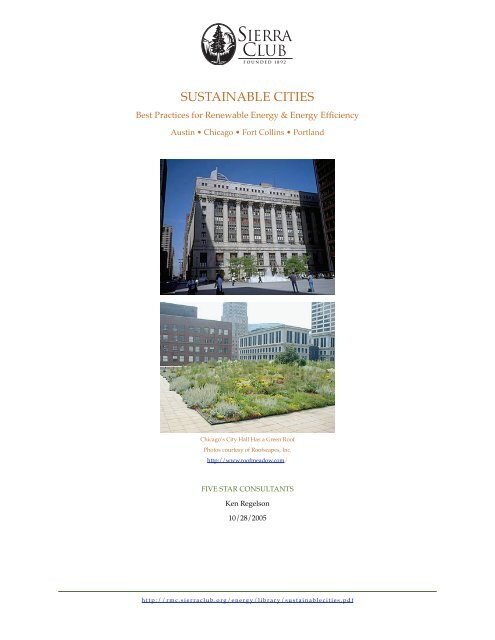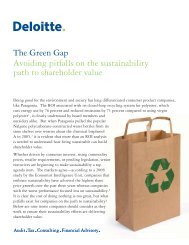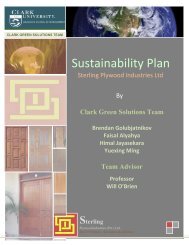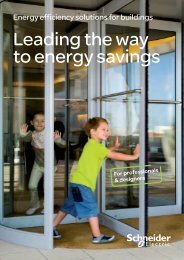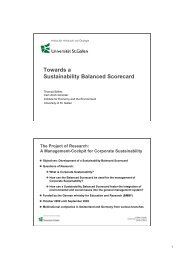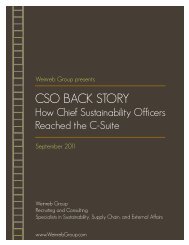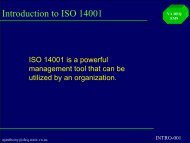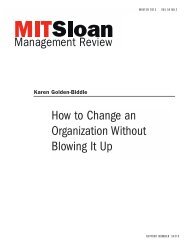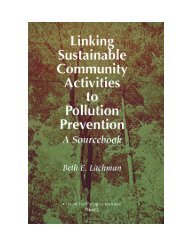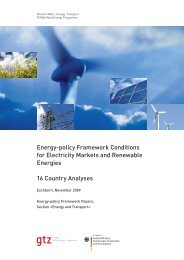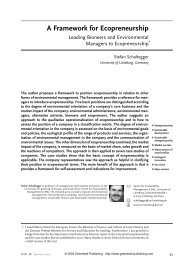SUSTAINABLE CITIES - Sierra Club Rocky Mountain Chapter
SUSTAINABLE CITIES - Sierra Club Rocky Mountain Chapter
SUSTAINABLE CITIES - Sierra Club Rocky Mountain Chapter
You also want an ePaper? Increase the reach of your titles
YUMPU automatically turns print PDFs into web optimized ePapers that Google loves.
<strong>SUSTAINABLE</strong> <strong>CITIES</strong>Best Practices for Renewable Energy & Energy EfficiencyAustin • Chicago • Fort Collins • PortlandChicago’s City Hall Has a Green RoofPhotos courtesy of Roofscapes, Inc.http://www.roofmeadow.com/FIVE STAR CONSULTANTSKen Regelson10/28/2005h t t p : / / r m c . s i e r r a c l u b . o r g / e n e r g y / l i b r a r y / s u s t a i n a b l e c i t i e s . p d f
IntroductionWhy?Why try?Why should a city even try to be sustainable?Why do Austin, Chicago, Fort Collins, and Portland care about being green or sustainable?These cities told us investing in renewable energy and energy efficiency programs helped them:•••••Save Money - literally millions of dollars each year.Provide economic benefits to their residents.Reduce future energy cost risks.Comply with and improve upon Federal clean air standards.Provide a more livable environment.And just as importantly, their residents approve of these programs (e.g., some Austin programs receive 94% approvalratings).What?This report documents innovative and successful programs U.S. cities are using to become more sustainable. Throughweb research and telephone interviews, the author researched numerous municipal programs for renewable energy(RE) and energy efficiency (EE).Four cities were chosen for an in-depth look into the history, status, and results of their RE & EE programs. Initially,we conducted cursory research on Minneapolis, Salt Lake City, Denver, Burlington, and others. Ultimately, we choseAustin, Texas, Chicago, Illinois, Fort Collins, Colorado, and Portland, Oregon, for further study as they offered thebest breadth and depth of sustainability programs and goals with a mix of city size and utility ownership models.We wish time allowed an in-depth look at all the other cities we researched. Most cities appear to have programs inRE & EE that others can learn from.Attractive, affordable, and green moderateincome home in Portland.This report was funded by the <strong>Sierra</strong> <strong>Club</strong> and sponsored by the Clean Energy Campaign of the <strong>Rocky</strong> <strong>Mountain</strong><strong>Chapter</strong> of the <strong>Sierra</strong> <strong>Club</strong>.S u s t a i n a b l e C i t i e sA u s t i n • C h i c a g o • F o r t C o l l i n s • P o r t l a n d1
Executive SummaryFour cities were selected for a review of their practices and programs using renewable energy (RE) and energy efficiency(EE) to become more sustainable. Through the course of the interview and research process, a number ofcommon key elements came to light. Not every element is used in each city, but most of these elements were commonto these cities. This report finds that the key elements for implementing sustainability in cities are:Leadership - most often the original impetus came from a mayor or councilperson. In Chicago, for example, MayorDaley’s often-expressed goal is to “make Chicago the greenest city in America.”A Plan - All had a master plan or roadmap to follow.Funding - This element saw the most variation among the cities. Funding for EE and RE investments came from electricpower rates, grants, state programs, and integration into normal city budgets. These investments lead to...Reduced Energy Costs - Portland municipal buildings save $2.3 million per year from EE. Austin, by using EE, essentially“built” a 500 Megawatt (MW) conservation power plant at a fraction of the consumer cost and environmentalimpact of a traditional coal plant. Austin is currently working on its second conservation power plant.Communications - Excellent websites include details on programs, customized fact sheets (e.g., on green building practices),reports, and case studies. All had award programs or on-line showcases for excellence in green building.Training - Rather than emphasize EE and RE as topics themselves, resident and business training often focused on thehuman concerns of saving money, or sealing leaks for comfort, or on indoor air quality and health.Inspections, Audits, and Measurement - Free or low cost energy audits and inspections are provided. Measurements andanalysis help insure that RE and EE investments are cost-effective and popular with residents. Commissioning ofbuildings verifies that RE and EE equipment is installed and operating properly.Efficiency Rebate Programs - These were often targeted to specific reductions in peak electricity use, with efficiency rebatesset as a fraction of the projected cost of building the next power plant.Renewable Programs - Programs include both green energy purchasing programs and rebates for resident sited solar.Green Building - Lead by example. Start with city-owned buildings to develop local expertise. Green building wasthen encouraged generally with assistance, rebates, grants, award programs, and some regulation.Multi-family Building Programs - Programs focused on the needs of renters and apartment owners.Income Qualified Programs - Recognizing that low income residents most need the comfort and money savings fromEE, but can least afford it, these cities provide additional incentives for EE for qualified-income residents.New Businesses. New Jobs - Several cities are working to specifically attract clean RE & EE businesses. The moneysaved on energy bills, as well as the money spent on EE & RE programs produce jobs locally (rather than in remotecoal mines and power plants).Green roofs - Chicago and Portland have green roof programs for the benefits of energy savings, urban heat islandreduction, rainwater retention, air quality improvement, and beautification. Interestingly, even with its hot and dryclimate, Austin is now researching green roofs.S u s t a i n a b l e C i t i e sA u s t i n • C h i c a g o • F o r t C o l l i n s • P o r t l a n d2
What follows is a city-by-city look at the programs Austin, Chicago, Fort Collins, and Portland use to save moneyand improve the lives of their residents by investing in renewable energy and energy efficiency programs.This document was written with city managers and staff in mind. Nevertheless, we hope that many people find ituseful, particularly those responsible for improving energy quality while reducing energy costs in their communities,and those that want to make their cities more sustainable.Because of the many weblinks embedded in this document, it is best viewed as an Adobe Acrobat “PDF” file on yourcomputer. You may download this document from:http://rmc.sierraclub.org/energy/library/sustainablecities.pdfQuick ComparisonCITYELECTRICITYPOPULATIONRAINFALLCOOLINGHEATINGPROVIDED BY(INCHES)DEGREEDEGREEDAYSDAYSAustin Muni 650,000 33 3015 1687Chicago IOU 2,890,000 36 940 6176Fort Collins Muni 130,000 15 479 6367Portland IOU 530,000 37 371 4522Note that Portland is trying to purchase its IOU and turn it into a co-op or muni.IOU = Investor Owned Utility. A corporation provides electricity to the city.Muni = municipally owned utility. A publicly (city) owned utility provides electricity.Cooling Degree Days = a measure of how much cooling someone living in that city might want. The higher the numberthe more time air conditioning would be wanted. Austin has the highest need for air conditioning.Heating Degree Days = a measure of how much heating someone living in that city might want. The higher the numberthe more time heating, for example a furnace, would be wanted. Austin has the lowest need for heating.http://www.worldclimate.com/define.htmS u s t a i n a b l e C i t i e sA u s t i n • C h i c a g o • F o r t C o l l i n s • P o r t l a n d3
!us"#Population 650,000. Metropolitan Area: 1,250,000. Land area: 272 sq. miles. Rainfall: 33 inches per year. Cooling degreedays: 3015. Heating degree days: 1687. Seven council members are elected. Council selects a city manager.Electricity is provided by the municipally-owned Austin Energy (AE). Natural gas is provided by the Texas Gas Service.Peak electricity load occurs on weekday afternoons in the summer.LeadershipEE and RE programs began in 1982. Austin is working toward being the “Clean Energy Capital of the World.” TheAustin City Council, Austin Energy, the Chamber of Commerce, and the University of Texas actively participate inthe city’s renewable energy programs. The Chamber has a Clean Energy Council to expand on the region’s alternativeenergy industry. The original impetus came from then city council member, and present Deputy Manager of AustinEnergy, Roger Duncan.A PlanAustin Energy’s strategic plan goes into detail on the whys, whats, hows, and programs to achieve its vision and mission.Vision: “We want Austin to be the most livable community in the country.”Mission: “To deliver clean, affordable, reliable energy and excellent customer service.”Austin Energy’s primary objectives for its service area are: excellent customer satisfaction, to create and sustain economicdevelopment, provide exceptional system reliability, maintain financial integrity, and a strong commitment toa renewable portfolio standard (RPS). The RPS is viewed as integral to the other objectives through its reducing bothcosts and electricity supply cost risks.The plan states: “we have two measures for our energy resource objective. Our first measure is to achieve a renewableportfolio standard of 20% by 2020. For our second measure, we intend to achieve an energy efficiency target of 15%also by 2020.”http://www.austinenergy.com/About%20Us/Newsroom/Reports/strategicPlan.pdfS u s t a i n a b l e C i t i e sA u s t i n • C h i c a g o • F o r t C o l l i n s • P o r t l a n d4
AustinFundingAs a municipal utility, Austin Energy is funded through the inclusion of costs in customer rates. However, any increasedcosts due to efficiency measures or renewable initiatives are being offset by the decreased rates associatedwith not having to build new power plants. The utility obtains grants and low and zero interest loans through stateand federal programs.Reduced Energy CostsOver time, the combined decreases in energy demand associated with efficiency and renewable programs have savedthe city from electricity needs equal to the annual output of a 500 megawatt power plant. Through thoughtful applicationof such measures, Austin has in essence built a “conservation power plant” instead of an actual coal firedplant. A plant of that size can power 50,000 homes.The real-cost savings are well illustrated by measures taken within the city’s schools. AE managed and implementeda retrofit program for the school district on 40 schools (3.5 million square feet). Combined total costs were $3.8 Million.The state provides low interest loans for this kind of project. Combined rebates (similar to rebates offered to allcustomers) were $0.6 million, thus saving the district $480,000 per year in energy costs. The payback is 6.9 years onenergy costs alone. In addition to reducing energy usage, the retrofits improved bad lighting and reduced maintenanceproblems and cost.CommunicationsAE has an excellent Website - easy to use and informative.Online case studies can be found athttp://www.ci.austin.tx.us/greenbuilder/mcs_toc.htmAE’s Green Building Newsletter helpskeep contractors and others interestedin green building up to date.TrainingContractors are trained and qualified inorder to be recommended by AE for EE and RE work. Ongoing training is provided through monthly contractormeetings.Inspections, Audits, and MeasurementEnergy audits are free to everybody - all rate classes. In some cases energy audits are offered to renters as well (seebelow).S u s t a i n a b l e C i t i e sA u s t i n • C h i c a g o • F o r t C o l l i n s • P o r t l a n d5
AustinAustin Energy inspectors do pre and post inspections for EE and RE installations to insure quality.Building commissioning is becoming increasingly important in Austin. For example, IBM was so pleased with theenergy savings from commissioning one of their buildings that they want more of their existing buildings commissioned.Efficiency Rebate ProgramsAE is attempting to save an additional 40 to 50 MWs of load every year through efficiency.EE programs are targeted to the different needs of residential, small, or large business customers. For public schoolsand Austin municipal buildings, Austin Energy provides both rebates and project management services through theuse of inter-local agreements. Schools and the city pay Austin Energy for their service above and beyond the servicesnormal commercial and residential customers receive.Large businesses are audited for free by Austin Energy auditors. The rebate level is set to $250 per kW peak capacitysaved. Large businesses then have the necessary work completed through their normalcontractor network.Small businesses are also offered free energy audits by Austin Energy auditors. Butbecause they do not typically have a person or group devoted to facilities or energy, AEhandles the post-audit retrofitting in a more hands-on nature. After an audit, smallbusinesses need only sign a contract to pay 20% of the costs and AE does the rest. AustinEnergy has agreements with pre-selected contractors who do the work. The contractorreceives 80% of their reimbursement from AE directly. The 20% cost paid bysmall businesses is often recouped in electric bill savings in the first year. To maintain abalance between large and small business efficiency customers, small customers had toreceive a higher incentive — about $400 per kW peak saved.About 60% of commercial rebates go toward lighting.Rebates are based on the kilowatts (kW) of peak demand reduced over normal or codeequipment. The full cost of new fossil fueled generation is about $1500/kW (about$550/kW capital costs, balance for operations, maintenance, and fuel). Since the costsof EE are between $250 and $400 per kW, this is a win-win situation for customers anda power company determined to keep costs low.New construction qualifies for rebates where equipment exceeding Austin’s standardbuilding code requirements is used.Residential efficiency rebate programs are handled by contractors trained and certified by AE. The customer calls thecontractor, the contractor performs the audit and submits a bid proposal to AE. AE then reviews the bid and approvesit after an on-site visit. A residential customer can choose rebates on a cash basis, or can choose a zero percentloan from a local credit union arranged by AE.AE provides a $35 incentive for residents to remove and recycle working old refrigerators and freezers.S u s t a i n a b l e C i t i e sA u s t i n • C h i c a g o • F o r t C o l l i n s • P o r t l a n d6
AustinGreen BuildingThe City of Austin started the first Green Building Program in the U.S. in 1991. Operated by Austin Energy since1998, the program evaluates the sustainability of residential single family, multi-family and commercial buildingsusing locally developed rating tools or the USGBC’s LEED program. In addition to evaluating the level of sustainabilityof buildings, program staff provide plan review and recommendations, individual consultation on products andsystems, and assistance in applying for incentives or assistance from other City departments or programs to the constructionindustry. The program provides monthly seminars on various Green Building topics for industry professionals.In addition to working with industry to develop a supply of green buildings, the program works with the public todevelop demand for more green homes and offices. The Green by Design workshops are held quarterly and still attractfull houses of 80 to 100 people after more than three years. Ads and articles written by program staff promotingthe benefits of green building and builders who have participated in the program during the previous year are run inthe local media.AE offers a voluntary program for builders to acquire a Green Building star rating for their new construction. Buildersare trained, then fill out a checklist. AE inspectors visually check that the items listed in the checklist are installed.In the last year, 1,087 homes - 25% of new, single family construction - were star rated in Austin Energy’s service area.As of 2000, all new city-owned buildings must be at least LEED Silver standard.The redevelopment of the now closed Robert Mueller Municipal Airport will contain over 5 million square feet ofcommercial space and over 4,000 residential units when built out. All commercial buildings must meet either a LEEDSilver standard or attain 2 stars on the Austin Energy Green Building Program’s Commercial Rating tool. All housingmust meet an Austin Energy Green Building three star level.AE’s website features approximately 30 fact sheets addressing a variety of green building options from Air Filters toWindows. They were written specifically for the Austin environment, and are intended for both home and businessowners. Case studies and other educational information can also be found on the website at:http://www.ci.austin.tx.us/greenbuilder/The Sustainable Building Sourcebook is another valuable tool found on the AE website. The Sourcebook is designedto educate and inform all readers, but is directed specifically to motivated laypersons and those with a sound knowledgeof building trades and terminology. Like the fact sheets, the Sourcebook is written specifically for Austin andcontains information on regulatory issues, climate, installation guidelines, and sources of assistance.http://www.ci.austin.tx.us/greenbuilder/srcbk_1.htmS u s t a i n a b l e C i t i e sA u s t i n • C h i c a g o • F o r t C o l l i n s • P o r t l a n d8
$hicagoPopulation: 2,890,000. Metropolitan Area: 8,400,000 Land area: 228 sq. miles. Rainfall: 36 inches per year. Cooling degreedays: 940. Heating degree days: 6176. Mayor is elected. City Council consists of 50 Aldermen.Sustainability as a major goal started in 2000.Electricity is provided by the investor-owned ComEd. ComEd is a division ofExcelon Corporation. Natural gas is provided by Peoples Energy.Peak load occurs mid-day during the summer.Chicago is a member of the Chicago Climate Exchange. While the city does trackits greenhouse gas emissions, it does not trade them, preferring to bank or retirethem.http://www.chicagoclimatex.com/LeadershipMayor Richard M. Daley’s oft-stated goal is for Chicago to become “the most environmentally friendly city in America.”Mayor Daley has suggested that “encouraging environmental innovation will be beneficial for the health of bothour citizens and our economy. Conserving natural resources, and encouraging environmentally efficient behaviorfrom citizens and businesses, not only ensures the sustained health of the City but it also makes plain common sense.Why be wasteful when we can save? Save environmental resources, tax payer dollars, business costs and the qualityof life in our great neighborhoods.”“Leading by example” is Chicago’s intent. The city has established aggressive goals for city and allied agency buildings,including a target of 20 percent municipal electricity from renewables by 2005, and an envisioned 30% reductionin environmental footprint by 2020.Investor-owned electricity provider ComEd appears to share this leadership: “At ComEd we recognize the importanceof balancing the need for reliable energy with our responsibility to ensure that the quality of our environment ispreserved.”A PlanIn 2005, Chicago released an 80-page Environmental Action Agenda: Building the Sustainable City. The comprehensiveand detailed plan is divided into 17 functional areas - Airports to Waste and Recycling.S u s t a i n a b l e C i t i e sA u s t i n • C h i c a g o • F o r t C o l l i n s • P o r t l a n d10
ChicagoThere are three primary strategies within the agenda:1. Conserving, protecting, and restoring natural resources.2. Encouraging healthy environmental practices.3. Leading by example.Each functional area has sections for Mission, Accomplishments, Action Agenda for 2005, and Action Agenda for2010/2020.Part of this plan is a commitment to “develop ‘life-cycle cost assessment’ tools and data in addition to a first costanalysis method for budgeting.”http://egov.cityofchicago.org:80/webportałCOCWebPortałCOC_EDITORIAŁEnvActionAgenda.pdfFundingInitial funding was helped greatly by a 1999 settlement agreement with ComEd for $100 million. The settlement cameabout after power failures during major heat waves in 1995 and 1999 resulted in hundreds of deaths.EE & RE projects are paid for via the settlement fund, together with grant monies, funds from the city budget, andother funding mechanisms.Additional funding of $6 million was negotiated within the Chicago municipal franchise agreement with ComEd.This was used partially to fund the Chicago Solar Partnership.http://www.chicagosolarpartnership.comReduced Energy CostsThe City is in the process of auditing and retrofitting 15 million square feet of public buildings with efficient equipmentfor heating and cooling, lighting and ventilation. Energy savings are estimated to be $6 million annually. In addition,the retrofits will reduce annual pollution significantly — an estimated 30,000 tons of carbon dioxide, 84 tons ofnitrous oxides and 128 tons of sulfur dioxide.CommunicationsChicago has an excellent website providing easyaccess to city programs and reports.http://www.cityofchicago.org/Environment/GreenTech/andhttp://www.cityofchicago.org/Environment/GreenTech/sub/how.htmlS u s t a i n a b l e C i t i e sA u s t i n • C h i c a g o • F o r t C o l l i n s • P o r t l a n d11
ChicagoTrainingOn-line surveys and residential EE fact sheets are available fromthe REAP (Residential Energy Assessment Program) website.http://erc.supergloo.net/tips.htmThe city offers Boiler Efficiency and Motor Master workshops,along with more than 40 other free seminars at Chicago’s “GreenTech U” on green building and sustainability topics. These seminarsare held in the nation’s first LEED Platinum certified renovatedbuilding. Green Tech U has served almost 2000 professionalsand other Chicago residents.http://www.cityofchicago.org/Environment/GreenTech/Chicago places an emphasis on teaching kids about solar. Curriculumsand on-line interactive diagrams and quizzes have been developedfor young students.http://www.chicagosolarpartnership.com/teaching_tools/index.htmInspections, Audits, and MeasurementChicago plans to have an integrated global building management system for all city buildings in order to monitor,measure, and control energy usage.The city is also working towards commissioning all city-owned buildings.Efficiency Rebate ProgramsThe Industrial Rebuild Program (IRP) is a partnership of the City of Chicago Department of Environment (DOE),ComEd, the University of Illinois at Chicago’s Energy Resources Center and the Illinois Waste Management and ResearchCenter (WMRC). The program helps the most energy- and waste-intensive industries in Chicago becomemore energy efficient.The partnership optimizes its effectiveness by focusing on one industry at a time. Over the program’s three-year life,the IRP has targeted the metal casting, chemical, and confectionary industries. Companies in identified sectors aregiven free energy and pollution assessments, which include suggested improvements in energy efficiency, pollutionprevention and water conservation. An estimated cost/benefit analysis is then produced for each suggested improvement.A revolving loan program offers low- or no-interest loans for implementing energy conservation measures.The loan program is tied to renewable energy goals. The City offers 0% interest loans to companies that purchase5% of their electric energy use from renewable energy (e.g., wind power). Not only does this program helpcompanies become economically competitive by reducing their energy use, it helps create a market for renewableenergy in the city. IRP anticipates energy savings in the neighborhood of 10% to 25%.S u s t a i n a b l e C i t i e sA u s t i n • C h i c a g o • F o r t C o l l i n s • P o r t l a n d12
ChicagoRenewable ProgramsCitywide, Chicago currently has 1.2 MW of installed solar electric systems. 2.5 MW of solar thermal is being installedfor solar pool heating, domestic hot water, and space heating in fire houses, aging centers, health centers, and policestations. Chicago’s goal is to produce 10 MW of renewable energy by 2010.In addition to Chicago’s direct purchase of renewables, the city helps build demand for renewable technologythrough implementation of the Industrial Rebuild Program detailed above.Rebates are available for solar electric systems from the state and from ComEd. These work out to about $3.50 perwatt for a 2 kW residential system.Green BuildingBecause city buildings are expected to have a 100-year life, the city has made a huge commitment to designing andbuilding superior new structures. The mindset is that it is in the city’s own best interests for its buildings to be extremelyenergy efficient. In addition, green buildings use less toxic materials and generally provide nicer work environmentsthan traditional structures.A single general services department provides expertise in green building and efficiency for all city departments.If a commercial builder takes city money under a grant program for a new building, their end-product must have agreen roof, be ENERGY STAR® compliant, or be LEED certified.In 2004, the city adopted the “Chicago Standard,” requiring that all new and renovated city-owned buildings beLEED certified.The Green Bungalow Program renovated four abandoned bungalows for moderate income ownership. Energyefficientand environmentally sustainable rehabilitation techniques incorporated into the project afforded energy savingsof up to $1,050/year. Drawing considerable public attention, the program was publicized through newspaperand magazine articles, websites and conference presentations. Over 2,000 people have toured the homes.The Green Homes Design Competition was a collaboration between the City of Chicago, Neighborhood HousingServices of Chicago, and others, to build and sell energy-efficient, environmentally-friendly and affordable homes.The competition selected five homes from seventy-three entries. The homes were open for tours, and are still open forvirtual tour on Chicago’s website.Mayor Daley’s GreenWorks Awards were created to recognize outstanding examples of green building in Chicago’sprivate sector.Chicago’s Green Permit Program (GPP) is an express building permit process for ENERGY STAR or LEED buildings.GPP can reduce the number of days for a building permit from a typical 3 months to as little as 15 business days - thegreener the building, the better the benefits. In addition, Chicago is identifying, and working to eliminate, buildingcode barriers that unnecessarily impede building green.http://egov.cityofchicago.org/webportałCOCWebPortałCOC_EDITORIAŁGreenPermitbrochure.pdfS u s t a i n a b l e C i t i e sA u s t i n • C h i c a g o • F o r t C o l l i n s • P o r t l a n d13
ChicagoMulti-family Building ProgramsMost of the multi-family EE activity in Chicago has been aimed at either city-owned or managed properties. 63 multifamilybuildings - or 1,447 units - have been rehabbed since 1988. Seven new multi-family buildings - 570 units - havebeen built so as to maximize energy efficiency. Results include an average space heating reduction of 50%.Income Qualified ProgramsWorking with other agencies, the city has created theNew Homes for Chicago Program.The award-winning New Homes for South Chicago projectis being developed by Claretian and Associates inpartnership with the Chicago departments of Housingand Environment. This 25-home project incorporatesmany energy efficiency features. For example, the homesare constructed with Structural Insulated Panels (SIPs).Half the homes will also include solar electric (Photovoltaic)systems. Funded and supported by a variety ofgrants and programs, the goal was to make this project asgreen as possible. Lessons learned so far include thatSIPs, while more expensive to buy, in fact cost out lowerthan standard construction framing due to reduced laborand waste cost.http://www.lisc-cnda.org/2005.php?recipient=claretianThe Green bungalow program provided affordable housingand is described in the Green Building section above.New Businesses. New JobsChicago has succeeded in attracting companies to thearea as a direct result of its concerted sustainability effort.Three companies that stand out are:• The Chicago Climate Exchange (greenhouse gas emissiontrading program)• Spire Corporation (manufacturer of solar electric panels)• Solargenix Corporation (manufacturer of solar thermal systems). Solargenix was encouraged to come to Chicagowith a startup loan and a procurement commitment (so many MWs of solar thermal per year).S u s t a i n a b l e C i t i e sA u s t i n • C h i c a g o • F o r t C o l l i n s • P o r t l a n d14
ChicagoGreen roofsGreen roofs are seen as a way to cut costs in several ways. First, they reduce heat in generally densely populated areas(reducing “urban heat islands”). Since air conditioning (particularly cooling) equipment is generally situated onthe roofs of most structures, roof temperatures impact the efficiency of A/C units directly. Chicago’s City Hall has apark-like green roof (see cover photo). Green roofs help alleviate this problem by keeping the air temperature on theroof much cooler than traditional roof materials. Green roofs also help with issues of storm runoff by slowing theflow of rainwater and are believed to be longer lasting than more traditional roofing systems.In Chicago, floor area bonuses may be granted for green roofs and other types of improvements.Eight projects have received density bonuses for constructing green roofs.150 public and private green roof projects have been installed totaling over two million square feet.There is a green roof grant program for small residential and commercial projects of up to $5000.http://egov.cityofchicago.org/webportałCOCWebPortałCOC_EDITORIAŁFlyer_1.pdfUrban heat island in Baton Rouge, La. (Source: EPA)S u s t a i n a b l e C i t i e sA u s t i n • C h i c a g o • F o r t C o l l i n s • P o r t l a n d15
%ort Co&in'Population: 130,000. Land area: 50 sq. miles. Rainfall: 15 inches per year. Cooling degree days: 479. Heating degreedays: 6367. The mayor and six city council members are elected.Demand side management programs started in 1980. Greenhouse gasplanning and management began in 1997.Electricity is provided by the municipally owned City of Fort CollinsUtility department. Gas is provided by the investor owned utility XcelEnergy.Peak load occurs during the late afternoon in the summer.LeadershipFort Collins city council has a long history of innovation in EE and RE.Most programs are implemented by the city-owned Fort Collins Utility. Electricity demand side management programsbegan in 1980. For example, see the ZILCH program below.Fort Collins Utilities became the first utility in Colorado, and the second utility in the nation to offer an optional greenpriced wind program in 1998. Greenhouse gas planning and management activities were added in 1999. The citycouncil adopted an Electric Energy Supply Policy in 2003, which raised electric rates to fund EE & RE programs. Thispolicy is having a big impact in energy sustainability. The goals and accomplishments of this policy may be found at:http://www.fcgov.com/utilities/powertosave/energygoals.phpThe city council continues its long-term leadership in sustainability with the 2004 formation of the Economic Vitalityand Sustainability Action Group (more below).A PlanFort Collins adopted a Local Action Plan to Reduce Greenhouse Gasses (a greenhouse gas management plan) in 1999.http://www.fcgov.com/airquality/lap.phpThis plan requires Fort Collins to “... implement municipal greenhouse gas reducing activities ... so as to reduce localgreenhouse gas emissions by at least 30% below predicted 2010 levels ...” The plan goes into detail on programs andanticipated savings from those programs.This led to the Electric Energy Supply Policy adopted by City Council in 2003.http://www.fcgov.com/utilities/energypolicy.phpS u s t a i n a b l e C i t i e sA u s t i n • C h i c a g o • F o r t C o l l i n s • P o r t l a n d16
Fort CollinsThe cost to the utility of helping customers save energy is about 1.7 cents per kWh. The cost to the utility of providingenergy is about 3.7 cents per kWh. In Fort Collins, therefore, it costs twice as much to provide electricity to the city’sconsumers as it does to save it.CommunicationsThe city’s award winning website is straightforward, easy to use, clear, and quick. (2004 Best of the Web)http://www.fcgov.com/news/index.php?ID=092004090410011Case studies of energy efficiency projects can be found athttp://www..fcgov.com/utilities/powertosave/casestudies.php“The Power to Save” campaign is an umbrella slogan used for all EE programs in the city.TrainingFor students, the “Energy Rules” program teaches lessons on energy conservation and renewables:http://www.fcgov.com/utilities/edu-energy.phpBusinesses may attend free talks in the Environmental Program Series. Each half-day talk covers a topic in some detail.Topics have included air conditioning, lighting, motors, cooling towers, best practices in green building, etc.http://www.fcgov.com/utilities/powertosave/events.phpPast presentations may be downloaded from:http://www.fcgov.com/utilities/business-eps-presentations.phpThe city helps sponsor, and contributes to, an annual weekend long Sustainable Living Fair.http://www.sustainablelivingfair.org/Inspections, Audits, and MeasurementBusinesses receive free energy assessments from the utility:http://www.fcgov.com/utilities/powertosave/energyassessment.phpFor homes, the Fort Collins Utility administers the ENERGY SCORE program.Qualified private contractors perform complete energy audits, for which theutility provides a $50 discount.http://www.fcgov.com/utilities/powertosave/energyscore.phpThe utility also encourages commissioning. For a good description of the commissioning process, visit:http://www.fcgov.com/utilities/powertosave/commissioning.phpS u s t a i n a b l e C i t i e sA u s t i n • C h i c a g o • F o r t C o l l i n s • P o r t l a n d18
Fort CollinsEfficiency Rebate ProgramsA variety of money saving programs, including clothes washer and air conditioner rebates, compact fluorescent lightbulbbuy-downs, and a bounty for recycling inefficient refrigerators and freezers, are aimed at meeting Fort Collins’goal of a 10% increase in overall energy efficiency by 2012.http://www.fcgov.com/utilities/powertosave/inyourhome.phphttp://www.fcgov.com/utilities/powertosave/business.phpFort Collins Utilities provides zero interest loans to homeowners forenergy improvements though its ZILCH (Zero Interest Loans for ConservationHelp) program.http://www.fcgov.com/utilities/zilch.phpFort Collins Utilities works collaboratively with its electricity supplier PRPA to provide up to $500 per kW DemandSide Management reductions in peak summer electric load relating to lighting retrofits and motors and air conditioningupgrades.http://prpa.org/productservices/dsmmain.htmRenewable ProgramsFort Collins’ goal for renewables is to have 15% of the city’s energy derived from renewable sources by 2017. In 2004,the city (city-owned buildings, residences, and businesses) had achieved 2.4% renewables. The existing renewableprograms are funded in part by a 1% increase in rates for renewables and also through a voluntary wind purchaseprogram.In 2004, the Platte River Power Authority reduced the rates for the voluntary wind program from 2.5 cents per kWhto 1 cent per kWh to better reflect the actual costs of wind power production.The city is looking into options for solar power starting with a pilot project on net metering, which would allow theutility to analyze full data on photovoltaic generated power. In a more broad sense, the utility is looking for ways tostreamline interconnection issues and encourage conservation, renewables, and customer-generated power (e.g., solar,or combined heat and power plants)Green BuildingThe Integrated Design Assistance Program provides consulting and financial assistance on new commercial buildings.The program encourages integrated design and commissioning with the vision of achieving energy savings inexcess of 20% beyond code requirements.http://www.fcgov.com/utilities/powertosave/indesign.phpAll new city-owned buildings will be built to at least LEED Silver standards. Fort Collins’ first Silver standard buildingwas completed in 2005.S u s t a i n a b l e C i t i e sA u s t i n • C h i c a g o • F o r t C o l l i n s • P o r t l a n d19
Fort CollinsFrom a builder’s perspective, new home energy efficiency is supported with the on-line Builder’s Guide to EnergyEfficient Home Construction.http://www.fcgov.com/electric/builders-guide/index.htmNew home purchasers can find excellent information in an easy to use format at:http://www.coloradonewhomechoices.org/home.htmThe buyer’s guide and the questions PDF on the Colorado new home website are worth a close look.http://www.coloradonewhomechoices.org/buyersguide/default.htmhttp://www.coloradonewhomechoices.org/questions/questions.pdfA comprehensive study of New Home Energy Efficiency was completed in 2002 andmay be downloaded from:http://www.fcgov.com/utilities/pdf/newhome-eval.pdfMulti-family Building ProgramsThis is an area where the utility expects to do more in the future.Income Qualified ProgramsFree weatherization services for income qualified residents are part of the REACH program (Residential Energy Assistancethrough Community Help).http://www.fcgov.com/utilities/reach.phpNew Businesses. New JobsThe EE programs have created new businesses and jobs. For example, Energy Solutions Unlimited, a lighting supplycompany specializing in energy efficient retrofits, has established its primary place of business in Fort Collins.Green roofsCool roofs (light or white colored roofing material) are recommended as part of the city’s green building programs.Due to the area’s relatively scant rainfall, however, Fort Collins has not invested significant resources in promotinggreen roofs thus far. This may change if programs in arid regions (e.g., in Austin) demonstrate any benefits of greenroofsS u s t a i n a b l e C i t i e sA u s t i n • C h i c a g o • F o r t C o l l i n s • P o r t l a n d20
(ortlan)Population: 530,000. Six-county metro area: 1,900,00. Land area: 134 sq. miles. Rainfall: 37 inches per year. Coolingdegree days: 371. Heating degree days: 4522. The mayor and 4 city commissioners are elected at large.Electricity is provided by the investor-owned Portland General Electric (PGE) and PacifiCorp. PGE is currently forsale by Enron (in bankruptcy). The city of Portland is attempting to buy PGE to make it into a municipal utility orcooperative.Peak load occurs in the early evening during the winter.LeadershipIn 1979 the city adopted an energy policy - one of the first, if not the first in the country, to emphasize energy efficiencyand renewables.Implementation of this energy policy and related policies addressing green building, recycling, sustainable procurement,and global warming is coordinated by the Office of Sustainable Development (OSD). OSD’s “mission is to provideleadership and contribute practical solutions to ensure a prosperous community where people and naturethrive, now and in the future.”The goal: The “City of Portlandwill promote a sustainablefuture that meetstoday’s needs without compromisingthe ability of futuregenerations to meet their needs, and accepts its responsibility to:* Support a stable, diverse and equitable economy.* Protect the quality of the air, water, land and other natural resources.* Conserve native vegetation, fish, wildlife habitat and other ecosystems.* Minimize human impacts on local and worldwide ecosystems.”These principles also establish requirements for elected officials and city staff.http://www.sustainableportland.org/greenpages/Sustainable_Principles.htmS u s t a i n a b l e C i t i e sA u s t i n • C h i c a g o • F o r t C o l l i n s • P o r t l a n d21
Key questions for the energy piece of the sustainablepuzzle are: “How can we use lessenergy? Should we build more power plants?Can we find new, cleaner, energy sources?How will our energy choices affect the air,water, and soils?”Portland, the county seat of MultnomahCounty, is working with the County to reducegreenhouse gas emissions to 10% below1990 levels by 2010. To date, progress is extremelyencouraging. A June, 2005 ProgressReport showed that GHG emissions in Portlandwere less than 1% above 1990 levels inthe face of both population and economicgrowth.Portland is truly a world leader in energy sustainability!http://www.sustainableportland.org/osd_pubs_global_warming_report_6-2005.pdfA PlanThe Local Action Plan on Global Warming is Portland’s guiding document for achieving its 2010 GHG objective. Thisis Portland’s second GHG plan the first having been issued in 1993.http://www.sustainableportland.org/Portland%20Global%20Warming%20Plan.pdfThis comprehensive plan addresses global warming and includes specifics on GHG emissions in Portland. It “identifiesfive primary components with specific greenhouse gas reduction targets and a sixth element - Policy, Research,and Education - that will enhance the success of the other five strategies but is not credited directly with quantifiablereductions.” Each component is broken down into objectives and actions. The five areas in which Portland explicitlycontemplates GHG reductions are:A) Policy, Research, and EducationB) Energy Efficiency in Buildings (0.67 million metric tons CO2 reduction)C) Transportation, Telecommunications, and Access (1.35 million metric tons)D) Renewable Energy Resources (0.54 million metric tons)E) Waste Reduction and Recycling (0.23 million metric tons)F) Forestry and Carbon Offsets (0.31 million metric tons)Local emissions are inventoried annually, and a comprehensive progress report was issued in June 2005:http://www.sustainableportland.org/default.asp?sec=osd&pg=pubsS u s t a i n a b l e C i t i e sA u s t i n • C h i c a g o • F o r t C o l l i n s • P o r t l a n d22
PortlandFundingOne of the early programs Portland adopted was the City Energy Challenge. This is an internal tax, or systems benefitcharge, which takes 1% from each city department’s energy bill to fund internal-to-the-city-government technicalassistance for energy efficiency projects. The program has a $15,000 cap, but nevertheless faced some early skepticism.Resistance subsided, however, as each department realized energy savings much larger than program’s costs.Approximately 8% of the Office of Sustainable Development’s funding comes from the city’s general budget. Fundingis applied strategically to maximize grants.Some programs require cost-sharing. For example, apartment owners pay the lion’s share of energy retrofits.The Energy Trust of Oregon is funded by a statewide Systems Benefit Charge (SBC) that began in 2001. The EnergyTrust funds energy efficiency and renewable energy projects in Oregon. Following the SBC’s initiation, utilities couldno longer recover costs on DSM programs through rates.The Energy Trust of Oregon is funded by a statewide Systems Benefit Charge (SBC) that began in 2001. The EnergyTrust funds energy efficiency and renewable energy projects in Oregon.http://energytrust.org/The Climate Trust provides funds for greenhouse gas offset projectsall over the world. Portland has received grants from theFund for a number of its initiatives - traffic signal optimization,the Multifamily Assistance Program, Internet based carpool matching, and the Commercial Green Buildings Program.The Climate Trust is primarily funded through a state law requiring new fossil fuel burning electricity generatingpower plants in Oregon to offset carbon emissions up-front. The program receives additional funding from otherstate and utility carbon-offset initiatives as well as contributions from individuals and companies. Projects are listedat:http://www.climatetrust.org/offset_projects.phpA carbon calculator and donations page may be viewed at:http://www.carboncounter.org/index.phpPrior to funding from the Energy Trust (financed by an SBC), some programs (e.g., the Multifamily Assistance Program)were funded by the local utilities as part of their Demand Side Management efforts. Prior to 2001, the OregonPublic Utilities Commission deemed DSM as cost-effective, or “prudent,” and allowed utilities to use rates to recovercosts for DSM programs. Utilities in Oregon may no longer recover DSM expenses in rates.In addition to the above, Oregon offers substantial tax credits for energy and building efficiency. These tax creditsmay be “passed through,” or transferred from one entity to another. This enables organizations with no tax liability,such as non-profits and local governments, to take advantage of the tax-based incentives by trading credits to entitiesthat pay taxes. (In the past these organizations were sometimes able to access the benefits of the tax credits by, forexample, leasing energy-efficiency equipment from entities with tax liabilities. The lessor would then qualify for thetax credits, thereby sharing in the financial benefit with the non-profit or government entity).Another state law encourages subsidized bus passes.S u s t a i n a b l e C i t i e sA u s t i n • C h i c a g o • F o r t C o l l i n s • P o r t l a n d23
PortlandThe City of Portland’s Green Investment Fund pools capital from the Energy Trust of Oregon and the City’s water,wastewater, and solid waste divisions to provide grants for innovations in building green.http://www.green-rated.org/gif.aspReduced Energy CostsThe City Energy Challenge saves Portland an estimated $2.3 million per year on its governmental energy bills.Over the next ten years, the four programs funded under the Climate Trust are expected to relieve the city of approximately0.5 million metric tons of CO2 emissions. The savings realized from these programs for the most part goto car owners and businesses benefiting from reduced energy use.Over the past ten years, Portland has helped weatherize 20,000 apartments and 2,000 low-income homes.CommunicationsExceptional websites provide ready access to programs, reports, case studies, and incentive programs. The two primaryresources are the “G Rated” site for green building, and the Office of Sustainable Development’swebsite.http://www.green-rated.orghttp://www.sustainableportland.org/The reports found here are particularly worth investigatinghttp://www.sustainableportland.org/default.asp?sec=osd&pg=pubsPortland has been recognizing outstanding sustainable businesses since 1993 through its Businessesfor an Environmentally Sustainable Tomorrow(BEST) awards.http://www.green-rated.org/prog_bestawards.aspThe Cool Portland Campaign is a prototype programlaunched in 2001, under which five to eight people -neighbors, friends, coworkers - formed teams that met three times over a 30-day period. The teams utilized a step-bystepworkbook and a trained volunteer coach to reduce GHGs from their lives. The teams achieved average reductionsof 6,300 pounds.http://www.sustainableportland.org/stp_glo_cool.htmlTrainingThe ReThink Green Building Training Certificate program runs for 5 months. This education program uses case studiesand features residential and commercial tracks. ReThink provides training and support for architects and buildersseeking to maximize energy efficiency. ReThink also educates participants on how to best utilize state providedgrants and tax credits for given projects. Expert-led tours and classes explore high performance design as integratedS u s t a i n a b l e C i t i e sA u s t i n • C h i c a g o • F o r t C o l l i n s • P o r t l a n d24
Portlandinto local projects. This year, ReThink adds a series of Design Forum evening lectures bynationally distinguished architects and urban designers..http://www.green-rated.org/prog_rethink.aspTravelSmart is a marketing and training program that encourages use of alternate transportation.Initial contact with Portland citizens begins with a letter, followed by a phonecall asking: ”Do you regularly bus or bike?” If the contact responds either “yes,” or “noand never will ride the bus,” the call is concluded with a thank you.If the contact responds with “sometimes, but x, y or z,” then TravelSmart staff works withthese people to help explain schedules, provide information, or even arrange a home visit. By providing a high levelof assistance to a small number of people, the program was able to reduce car trips by 8% among occasional alternatetransit users. Doing so optimizes use of the existing alternate transportation system while avoiding the need to addmore busses or bike lanes. TravelSmart markets the program with freebies like umbrellas, etc.http://www.trans.ci.portland.or.us/Options/TravelSmart.htmFix-It Fairs are neighborhood-based training programs that connect residents with resource conservation informationand assistance. Portland organizes about 3 such events each year. Fix-It Fairs feature concurrent sessions on a varietyof topics and typically take place in neighborhood schools. The events are advertised via flyers sent home throughthe schools and by direct mailings. The Fix-It Fairs are well attended, sometimes attracting up to 500 people. Topicsfocus on health and comfort rather than energy savings. For example, during a “drafty rooms” lecture, trainers telltheir audience about caulking cracks and other techniques to reduce drafts, alluding to financial and energy savingsonly as added benefits to comfort.http://www.sustainableportland.org/energy_res_fix.htmlInspections, Audits, and MeasurementPortland Energy Conservation, Inc. (PECI) is a city spin-off non-profit that performs building commissioning to verifythat building systems are working properly. Almost without exception, the building systems PECI evaluates areNOT working properly. PECI thus charges building owners a fee to provide consulting and to find and fix problemson their properties. Many building owners in Portland see this as a way to save building operation money.http://www.peci.org/Free energy audits are provided through the Energy Trust of Oregon.Residential energy and water use self-audit information and program listings can be found athttp://www.sustainableportland.org/greenpages/All_Around_My_House.htmandhttp://www.sustainableportland.org/greenpages/bathroom.htmS u s t a i n a b l e C i t i e sA u s t i n • C h i c a g o • F o r t C o l l i n s • P o r t l a n d25
PortlandEfficiency Rebate ProgramsPortland mandates the procurement of ENERGY STAR® office equipment for all city purchasing.Extensive (among the most comprehensive in the nation) rebate programs are provided through the Energy Trust ofOregon.http://www.energytrust.org/residentiałindex.htmlRenewable ProgramsPortland has been buying green tags for city departments since 1995. Currently about 11% of the city’s electricitycomes from green tags, micro hydro systems in the water system, plus the use of waste gas from wastewater treatmentin fuel cells and microturbines.Portland is currently soliciting bids for a partner to build a wind farm that would provide electricity for all of the cityownedfacilities and operations. The expectation is that the costs in the first year will not exceed current electricitycosts and that by contracting for 15 to 20 years, the city will insulate itself from any future electricity price increases.The 50 MW (approximate) wind farm would provide 100% of municipal electricity needs on average, essentiallyweaning the city’s dependence on non-renewable sources of electricity production (not residents and businesses).Rebates for the installation of solar electric, solar hot water, wind, biopower, and other innovative renewables areavailable through the Energy Trust of Oregon:http://www.energytrust.org/RR/index.htmlAs required under state law, Portland residents and businesses may purchase green power from their electric utilitiesthrough a voluntary customer-choice program. Currently, 7.8% of all Portland residents and businesses buy greenpower from their utility.Green BuildingPortland’s extensive green building programs can be accessed at:http://www.green-rated.org/default.aspPrograms range from financial incentives and technical assistance to green home tours, which allow 750 people to seeand appreciate tangible applications of the latest green building innovations up close and in person.Case studies for residential and commercial buildings can be found at:http://www.green-rated.org/cs_list.asp?md=residentialhttp://www.green-rated.org/cs_list.asp?md=commercialA guide for green home remodels is at:http://www.green-rated.org/publications_list.asp?cat=grgIntended for companies leasing or moving into new spaces, the book, G/Rated Tenant Improvement Guide -- Creating aHigh Performance Workspace, is available for free download from:S u s t a i n a b l e C i t i e sA u s t i n • C h i c a g o • F o r t C o l l i n s • P o r t l a n d26
Portlandhttp://www.sustainableportland.org/osd_pubs_ti_guide_jan_2004.htmlPortland LEED is a city-specific extension of the U.S. Green Building Council’s LEED standard. Information on PortlandLEED is available from:http://www.green-rated.org/p_leed.aspMulti-family Building ProgramsThe Multi-family Assistance Program assists apartment owners with maximizing the benefits of Energy Trust grantsand state tax credits. More than 10,000 multi-family units have been weatherized under the program since 2001.http://www.sustainableportland.org/energy_menu_Mul.htmlIncome Qualified ProgramsLow to moderate income apartment dwellers can get up to 100% funding from the Energy Trust of Oregon for energyefficiency projects.New Businesses. New JobsPECI is detailed above, under the “Inspections” section. Other notable Portland-area businesses related to sustainabilityinclude Green Building Services, Quantec, Stormwater 360, and PPM Energy, along with many others. A largenumber of green architectural, building, and installation firms are based in Portland. While those firms may benefitfrom Portland’s sustainable focus, they also help drive Portland’s mission towards increased sustainability.The Northwest Green Directory, an on-line database of regional green products and services, includes hundreds ofsustainability-oriented firms and products. Visit the directory at:http://www.nwgreendirectory.com/Green roofsEcoRoofs (Portland’s term for Green Roofs) are recommended by the city. Portland’s interest in green roofs comesmostly from the great potential for stormwater runoff benefits, but also from the possibility of achieving modest energyand heat-related benefits. Reducing the urban heat island effect is not a concern in Portland’s relatively cool climate.S u s t a i n a b l e C i t i e sA u s t i n • C h i c a g o • F o r t C o l l i n s • P o r t l a n d27
AcknowledgementsThis report would not have been possible without the kind support of many people including: Austin Energy’s RogerDuncan, Jerrel Gustafson, Fred Yebra, Ed Clark, Richard Morgan, and Ester Matthews; Michael Armstrong from Portland’sOffice of Sustainable Development; John Bleem from the Platte River Power Authority, John Phelan and PattyBigner from Fort Collins’ Utilities; Andrea Love and Mike Johnson with the City of Chicago, and Kathy Kelleher withClaretian & Associates.Special thanks to John Rosapepe from the <strong>Sierra</strong> <strong>Club</strong> who provided the original idea and funding for this report.Finally, a heartfelt thank you to my editor, Jason S. Wells.ResourcesIn addition to the web links listed throughout this report, some other excellent sources of information were found onbest practices in cities:Selected Best Practices for Successful City Energy Initiativeshttp://www.usmayors.org/uscm/news/press_releases/documents/bestenergy2001.pdfEnergy Efficiency Best Practiceshttp://www.eebestpractices.com/index.aspThe Environmental Protection Agency’s ENERGY STAR Program is responsible for helping the U.S. save enoughenergy to power 24 million homes while saving $10 billion. All four of these cities are ENERGY STAR Partners.http://www.energystar.gov/index.cfm?c=partners.pt_indexCities interested in sustainability should consider joining the Public Technology Institute’s (PTI) Sustainability Council.PTI is a non-profit organization that helps identify best practices for cities and counties. Their library containsmany documents for setting up programs and systems for financing and accounting for EE and RE.http://www.pti.org/While this report barely touched on issues of sustainable transportation, transportation needs must be addressed inall municipal settings in order to achieve any significant level of sustainability. In addition to a variety of forms ofmass transit, Plug-in Hybrid Electric Vehicles (PHEVs) are increasingly seen as a key component of our sustainableenergy future. Austin is organizing a number of cities to encourage auto manufacturers to develop PHEVs furtherand faster. For more information on Austin’s efforts, visit:http://www.pluginaustin.orgA PHEV is just like a regular Hybrid Electric Vehicle (HEV, such as the Toyota Prius) except that, unlike any HEVavailable today, PHEVs can plug-in to any normal electrical outlet and recharge a larger battery pack. Once charged,a PHEV can travel a certain number of miles (e.g., 20) as an electric vehicle with zero emissions. Even after calculatingin the emissions PHEVs contribute via electricity generation, they are cleaner and produce less carbon dioxide thanthe same gas operated HEV. When its charge runs out, a PHEV behaves exactly like a normal HEV.S u s t a i n a b l e C i t i e sA u s t i n • C h i c a g o • F o r t C o l l i n s • P o r t l a n d28
PHEVs can be set to charge late at night when electric rates are low and, in some places, when wind resources arehigh. With the right resources, PHEVs can even be set to charge from solar during the day. More information onPHEVs is available at:http://calcars.org/About the AuthorKen Regelson is the owner of Five Star Consultants. Ken provides analysis and cost-effective approaches to the use ofpolicy and practice to create a more sustainable energy future. Areas of expertise include utilities, net metering, municipalization,renewables, energy efficiency, and city and state policy and practice in RE and EE. He has been veryactive in the passage, rulemaking, and implementation of Colorado’s Amendment 37 - a renewable portfolio standardpassed by the citizen’s of Colorado in 2004. Ken’s clients include the <strong>Sierra</strong> <strong>Club</strong>, the City of Boulder, the ColoradoEnergy Science Center, the Center for Resource Conservation, the Colorado Solar Energy Industries Association (Co-SEIA), and others. He lives and works out of a solar powered home in Boulder, Colorado.regelson@mac.com303-449-4890This report may be downloaded from:http://rmc.sierraclub.org/energy/library/sustainablecities.pdfCool CitiesIf your city isn’t already a <strong>Sierra</strong> <strong>Club</strong> “Cool City,” please consider joining our campaign to help solve global warmingone city at a time.http://sierraclub.org/globalwarming/coolcities/S u s t a i n a b l e C i t i e sA u s t i n • C h i c a g o • F o r t C o l l i n s • P o r t l a n d29


